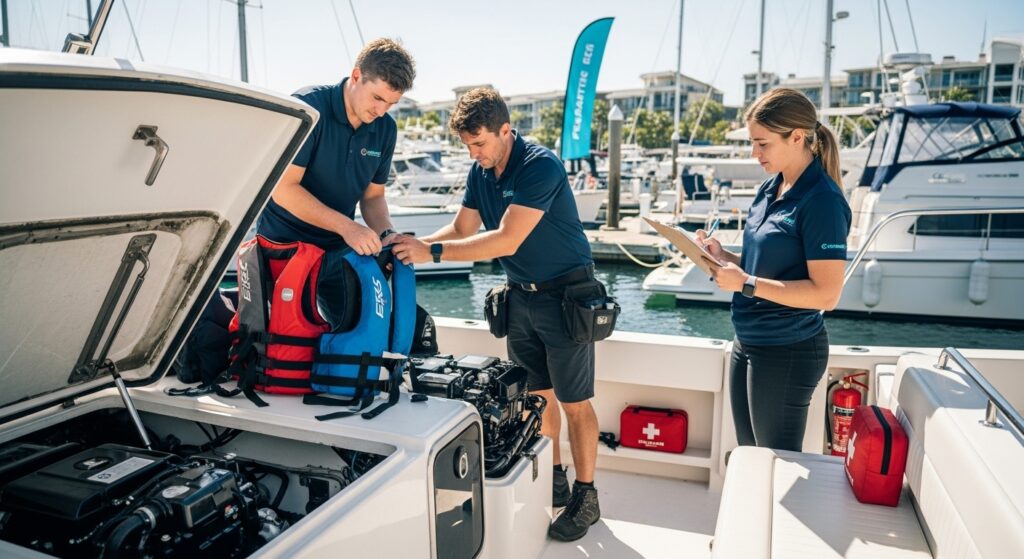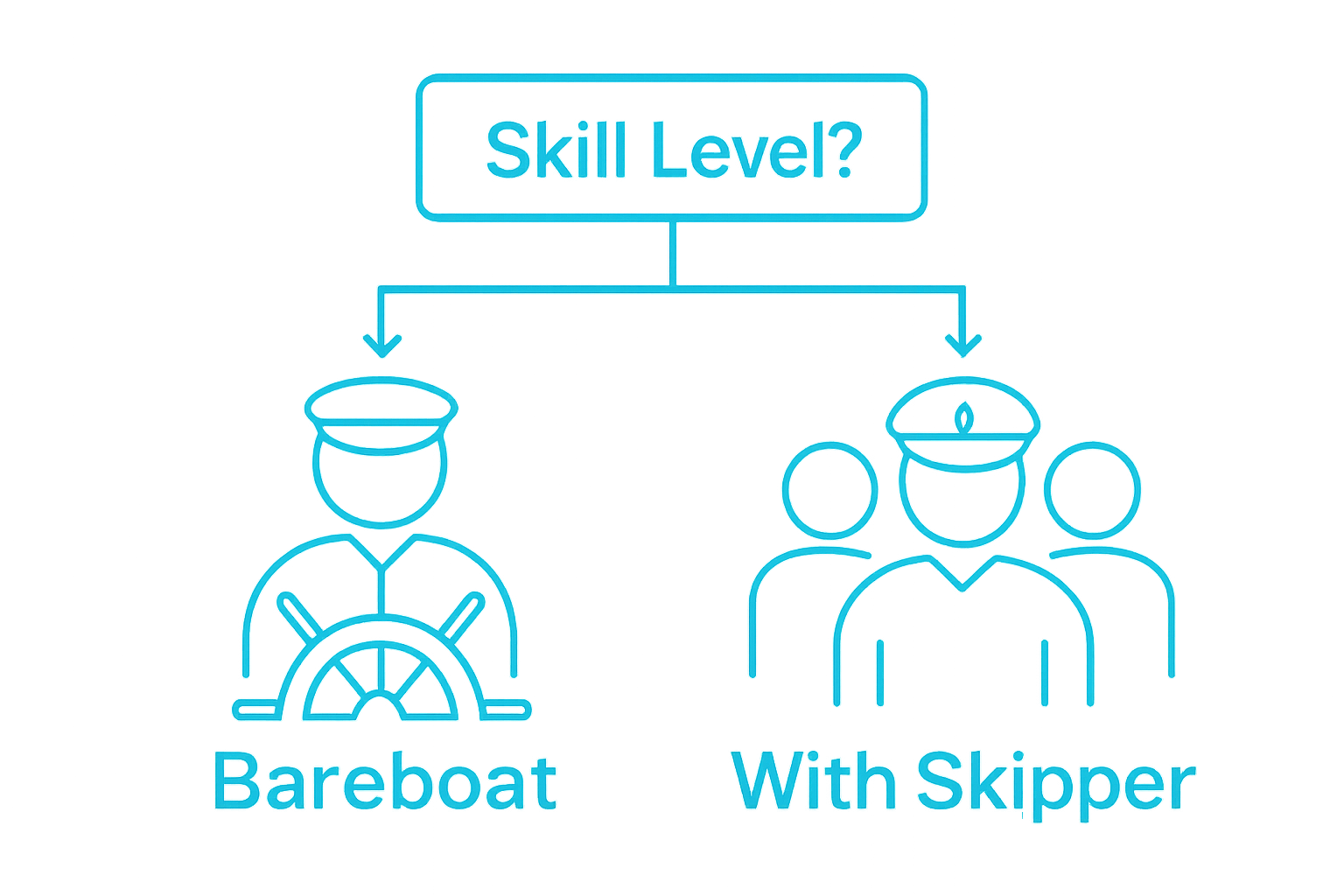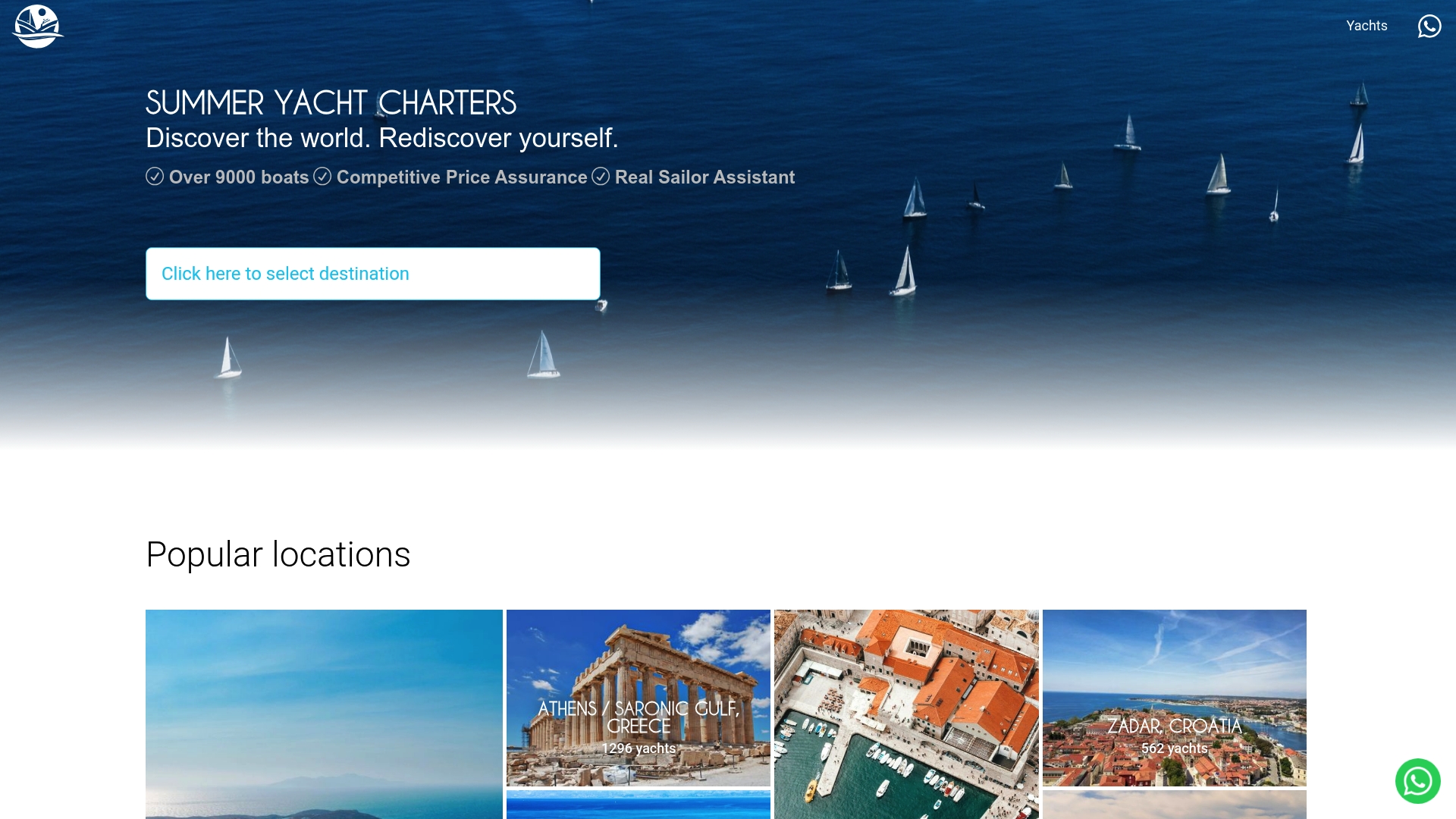How to Charter Your Boat: A Step-by-Step Guide
Learn how to charter your boat with our step-by-step process for an unforgettable sailing adventure. Perfect for all sailing enthusiasts.

Chartering a yacht might sound straightforward, just pick a boat and sail away, right? Yet only about 30% of first-time charterers are fully satisfied with their experience. That figure surprises most people. The twist is, the best sailing holidays have almost nothing to do with luck and nearly everything to do with rigorous planning long before you ever touch the water.
Table of Contents
- Step 1: Define Your Charter Objectives And Preferences
- Step 2: Research And Select The Right Charter Company
- Step 3: Choose Your Desired Boat Type And Specifications
- Step 4: Finalise Your Itinerary And Sailing Plans
- Step 5: Complete The Booking Process And Documentation
- Step 6: Verify Preparations And Conduct A Pre-Departure Check
Quick Summary
| Key Point | Explanation |
| 1. Define clear charter objectives | Establish your sailing goals, preferences, and group needs to ensure a tailored experience. |
| 2. Research and select a reputable charter company | Investigate reviews and feedback to choose a company with proven reliability and transparent pricing. |
| 3. Choose the right boat type | Select a vessel that matches your sailing experience and desired comfort level for an optimal adventure. |
| 4. Create a flexible sailing itinerary | Plan routes and consider contingencies to adapt to unforeseen weather or circumstances during your journey. |
| 5. Conduct thorough pre-departure checks | Inspect equipment, review safety protocols, and ensure crew readiness before setting sail for a worry-free experience. |
Step 1: Define your charter objectives and preferences
Chartering a boat begins with crystal clear planning. Your charter objectives will determine every subsequent decision, from vessel selection to destination choices. This critical first step transforms a potential sailing holiday from a vague dream into a precisely crafted adventure tailored to your specific needs and desires.
Understanding your personal sailing goals requires honest self reflection about your experience, comfort level, and trip expectations. Are you seeking a relaxed family vacation with gentle coastal cruising? Perhaps you want an adventurous sailing experience exploring challenging maritime routes? Professional sailors might prioritize performance vessels, while leisure travelers could prefer comfortable, stable yachts with ample amenities.
Consider several key parameters when defining your charter objectives. Your skill level plays a pivotal role in determining vessel type and charter arrangements. Experienced sailors might opt for a bareboat charter, which allows complete independent control. Less experienced sailors should consider hiring a professional skipper who can navigate local waters and provide expert guidance.
 Learn more about charter boat options to understand the range of possibilities.
Learn more about charter boat options to understand the range of possibilities.
Your group composition dramatically influences charter preferences. A romantic couples retreat requires different planning compared to a multi generational family holiday or an adventure trip with friends. Group size determines yacht dimensions, cabin requirements, and onboard facilities. Factor in everyone’s comfort, mobility needs, and individual expectations to ensure a harmonious sailing experience.
Budget represents another crucial objective definition parameter. Charter costs vary significantly based on vessel type, season, location, and additional services. Be transparent about your financial boundaries while remaining flexible. Sometimes investing slightly more can transform a good sailing holiday into an extraordinary maritime adventure. Remember that hidden costs like fuel, marina fees, provisioning, and potential insurance should factor into your total budget calculation.
Step 2: Research and select the right charter company
Selecting the right charter company is a pivotal moment in transforming your sailing aspirations into a memorable maritime adventure. This crucial step requires meticulous research, strategic evaluation, and a comprehensive understanding of what distinguishes exceptional charter services from mediocre ones.
Reputation and reliability form the cornerstone of your selection process.
Begin by investigating charter companies with established track records in delivering professional, high quality sailing experiences. Online reviews, testimonial platforms, and sailing community forums provide invaluable insights into a company’s performance. Look beyond glossy marketing materials and seek genuine feedback from previous charterers who can share authentic experiences about vessel condition, customer service, and overall trip satisfaction.
Financial transparency and comprehensive service offerings are equally critical considerations. Reputable charter companies provide detailed pricing structures without hidden fees, transparent insurance policies, and clear communication about included amenities. Examine their fleet diversity, maintenance standards, and additional support services. Explore our comprehensive yacht charter booking guide to understand the nuanced aspects of selecting the right charter partner.
Professional certifications and compliance with maritime regulations should never be overlooked. Verify that potential charter companies possess valid operational licenses, maintain rigorous safety standards, and employ professionally trained skippers and crew members. Request documentation demonstrating their adherence to international maritime safety protocols. A legitimate charter company will gladly provide evidence of their professional credentials and commitment to passenger safety.
Negotiation and communication skills become paramount during the selection process. Engage directly with charter representatives, asking targeted questions about vessel specifications, potential customization options, and contingency plans. Pay attention to their responsiveness, willingness to provide detailed information, and overall customer engagement. A company that demonstrates transparency, patience, and genuine interest in tailoring your experience is likely to deliver an exceptional sailing holiday.
Step 3: Choose your desired boat type and specifications
Selecting the perfect vessel is akin to choosing a traveling companion for your maritime adventure. Your boat type and specifications will dramatically influence your sailing experience, comfort, and overall trip satisfaction. This step demands careful consideration of multiple factors that extend far beyond simple aesthetic preferences.
Boat types represent distinct sailing personalities, each offering unique advantages and challenges. Monohull sailboats provide traditional sailing experiences with exceptional performance and a classic maritime feel. Catamarans offer superior stability, spacious deck areas, and reduced seasickness potential, making them ideal for families and less experienced sailors. Motor yachts deliver speed and luxury, perfect for those prioritizing comfort and rapid destination transitions. Explore our comprehensive guide to selecting your ideal summer vessel to understand the nuanced differences between boat types.
Technical specifications demand meticulous evaluation. Consider crucial parameters like vessel length, cabin configuration, onboard amenities, and performance characteristics. Smaller vessels typically range between 30 to 45 feet and work perfectly for couples or small groups, while larger yachts measuring 50 feet or more accommodate extended families or larger parties. Pay close attention to berth capacity, bathroom facilities, kitchen equipment, and storage spaces. These practical considerations significantly impact your onboard comfort and overall sailing experience.
Your personal sailing proficiency plays a pivotal role in boat selection. Experienced sailors might prefer performance oriented vessels that require active sailing skills, while novice charterers should prioritize stable, user friendly boats with simplified navigation systems. Consider additional factors like planned sailing routes, expected weather conditions, and group dynamics.
Below is a comparison table outlining the main types of charter boats mentioned in the article, helping you select the vessel that best fits your needs.
| Boat Type | Key Features | Ideal For |
| Monohull | Traditional sailing, performance focused, classic feel | Experienced sailors, classic enthusiasts |
| Catamaran | Stable platform, spacious decks, reduced seasickness | Families, less experienced sailors |
| Motor Yacht | Speed, luxury, fast destination changes | Comfort seekers, quick travel |
Step 4: Finalise your itinerary and sailing plans
Crafting the perfect sailing itinerary transforms a standard boat charter into an extraordinary maritime journey. This critical planning phase requires balancing adventure with practicality, ensuring your sailing experience combines exploration, comfort, and safety. Successful route planning goes far beyond simply connecting geographical points.
Navigational preparation demands comprehensive research about your chosen sailing region. Study maritime charts, understand local weather patterns, and identify potential anchorages, marinas, and interesting coastal destinations. Consider factors like prevailing winds, current strengths, nautical distances between stops, and seasonal navigation challenges. Learn expert techniques for planning your ideal sailing route to maximize your maritime adventure.
Flexibility remains paramount when designing your sailing blueprint. While detailed planning provides structure, experienced sailors understand the importance of adaptable itineraries. Build contingency time into your schedule, allowing for unexpected weather shifts, mechanical considerations, or spontaneous discoveries. Realistic daily sailing distances typically range between 20 to 40 nautical miles, depending on your vessel’s capabilities and crew experience. This approach prevents exhaustion and ensures enjoyable, leisurely exploration.
Practical logistics require meticulous attention to detail. Calculate fuel requirements, provisioning stops, and potential marina bookings well in advance. Research local maritime regulations, required documentation, and potential restricted zones along your planned route. Communication equipment, navigational tools, and emergency backup plans should be thoroughly evaluated and confirmed before departure. Consider creating a comprehensive float plan that includes your detailed route, expected arrival times at various waypoints, and emergency contact information. This document provides critical safety information and peace of mind for both your crew and local maritime authorities.
Step 5: Complete the booking process and documentation
The booking process represents the pivotal moment where your sailing dreams transform into concrete plans. This crucial stage demands meticulous attention to detail, comprehensive understanding of contractual obligations, and strategic financial preparation. Navigating the booking landscape requires both precision and thoroughness.
Initial documentation typically involves a comprehensive charter agreement that outlines every aspect of your maritime adventure. Carefully review the contract’s fine print, paying special attention to cancellation policies, damage deposits, insurance coverage, and potential additional fees. Some charter companies require substantial security deposits, often ranging between 30% to 50% of the total charter cost. These deposits protect the vessel owner and ensure your commitment to the booking. Explore our detailed yacht charter booking guide to understand the nuanced documentation requirements.
Financial preparation extends beyond the initial booking payment. Budget for additional expenses such as fuel surcharges, marina fees, provisioning costs, and potential equipment rental. Many charter agreements require a comprehensive insurance policy that covers potential vessel damage, personal liability, and medical emergencies. Professional sailors recommend obtaining specialized maritime travel insurance that provides comprehensive protection tailored to sailing environments.
The final documentation phase involves collecting and preparing essential personal paperwork. This includes valid passports, sailing certifications (if required), medical clearances, and any specific maritime licenses relevant to your destination. Some charter companies mandate proof of sailing competence, particularly for bareboat charters. Communication is key during this stage communicate proactively with your charter company, clarify any uncertainties, and ensure all submitted documentation meets their specific requirements. A successful booking process culminates in a detailed confirmation package that provides comprehensive information about your vessel, equipment inventory, and specific charter conditions.
Step 6: Verify preparations and conduct a pre-departure check
The pre-departure check represents the critical final gateway between meticulous planning and actual maritime adventure. This comprehensive verification process transforms theoretical preparation into practical readiness, ensuring your sailing experience launches smoothly and safely. Maritime safety is not about luck, but systematic preparation.
Equipment inspection demands thorough and methodical examination of every vessel system and safety component. Start with fundamental navigation equipment verification: GPS systems, marine charts, compass functionality, and communication devices must be fully operational. Check emergency equipment including life jackets, fire extinguishers, first aid kits, and emergency signalling devices. Ensure each piece of safety gear is accessible, correctly stored, and within its operational lifespan. Explore our comprehensive yacht charter planning checklist to understand detailed preparation protocols.
Mechanical systems require equally rigorous scrutiny. Inspect engine compartments for potential fluid leaks, check battery charge levels, examine fuel systems, and verify cooling mechanisms. Validate that all onboard systems function correctly electrical circuits, bilge pumps, steering mechanisms, and anchor winches. Pay special attention to potential wear and tear areas that might compromise vessel performance. Consider requesting a professional walk through with the charter company’s technical team, allowing them to demonstrate specific vessel peculiarities and answer any technical questions.
The final preparation stage involves a comprehensive crew briefing and safety orientation. Ensure every crew member understands basic maritime protocols, emergency procedures, and individual responsibilities. Review weather forecasts, discuss potential route modifications, and establish clear communication protocols. A well prepared crew transforms potential challenges into manageable situations, creating a foundation of confidence and collective preparedness that will define your entire sailing experience.
Use this pre-departure checklist table to ensure your vessel and crew are fully prepared for a safe and enjoyable sailing experience.
| Preparation Item | Purpose | Notes |
| Navigation Equipment | Confirm all electronic systems work | GPS, charts, compass, and communication devices |
| Emergency Gear | Guarantee safety protocols | Life jackets, fire extinguishers, first aid kit |
| Mechanical Systems | Prevent breakdowns | Engine, batteries, fuel, cooling systems |
| Safety Briefing | Crew understands roles and protocols | Emergency procedures and communication plans |
| Weather Review | Update routes for safe passage | Confirm forecast and adapt planned itinerary |

Turn Your Sailing Plans into a Seamless Charter Adventure
Planning to charter your boat is exciting, but tackling all the details—vessel choice, route planning, budget, and paperwork—can quickly become overwhelming. You are not alone if the thought of comparing over 11,000 yachts, filtering by destination and managing every stage of the booking process feels daunting. Many future charterers also worry about picking the right boat for their group, staying within budget, and making sure all contracts and safety checks are in order.
Discover how effortless your journey can be with Summer Yacht Charters. Our tailored platform lets you filter each vessel by date, discount, and location, bringing you handpicked yachts across the Mediterranean. Whether you’re dreaming of exploring the Ionian Islands or creating memories for a special occasion from our Celebrating life’s moments collection, we match your charter objectives with the perfect experience.

Take the next step and let your sailing adventure begin with experience, clarity, and personal guidance. Visit Summer Yacht Charters now to design your ideal charter while the best dates and boats are still available.
Frequently Asked Questions
What are the first steps to chartering a boat?
To begin chartering a boat, define your charter objectives and preferences by reflecting on your experience, comfort level, and budget. This will guide your choices regarding vessel type, destination, and whether you require a skipper.
How do I choose the right charter company?
Select a charter company based on their reputation, financial transparency, and compliance with maritime regulations. Research online reviews and engage with company representatives to clarify any questions and ensure they meet your needs.
What factors should I consider when selecting a boat type?
Consider your sailing experience, the size of your group, and the type of sailing experience you desire when choosing a boat. Factors include the type of vessel (monohull, catamaran, motor yacht), its specifications, and your planned sailing routes.
What should I verify during the pre-departure check?
During the pre-departure check, verify that all navigation equipment, emergency gear, and mechanical systems are functioning correctly. Conduct a thorough safety orientation with your crew to ensure everyone understands protocols and their responsibilities.
Recommended
- How to Book a Yacht Charter: Your Step-by-Step Guide – Summer Yacht Charters
- Smooth Sailing Ahead: First-Time Charterer Short Guide to Adventure!
- Yacht Charter Planning Checklist for First-Time Sailors – Summer Yacht Charters
- Yacht Charter Guide: Everything You Need to Know
- Understanding the Importance of Boat Maintenance
- PRIVATE CRUISES | byboat